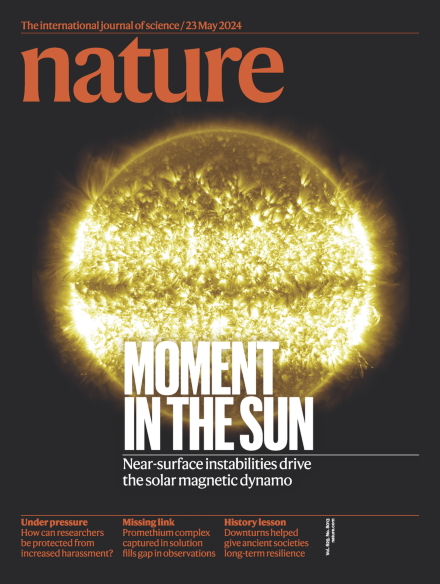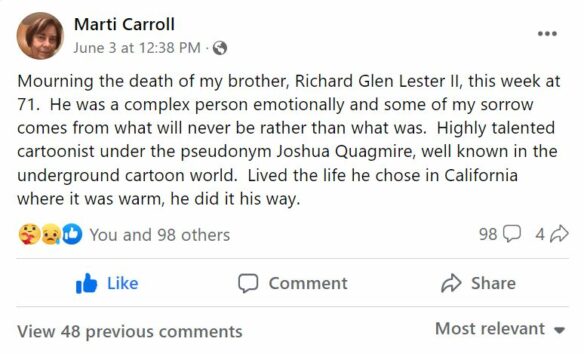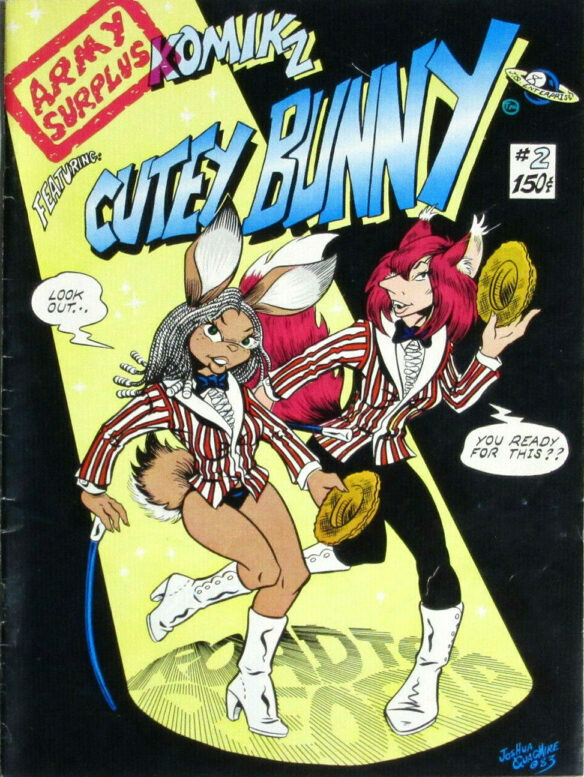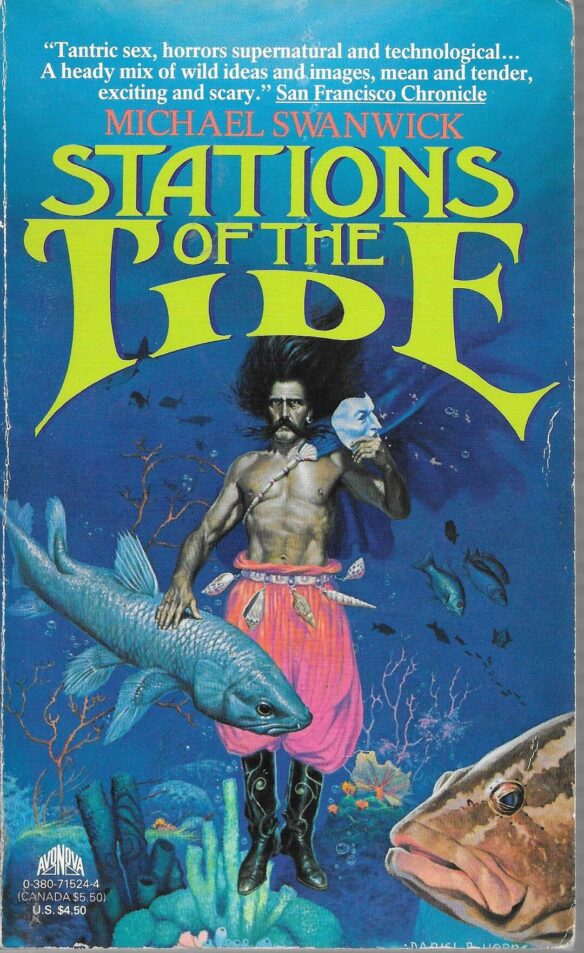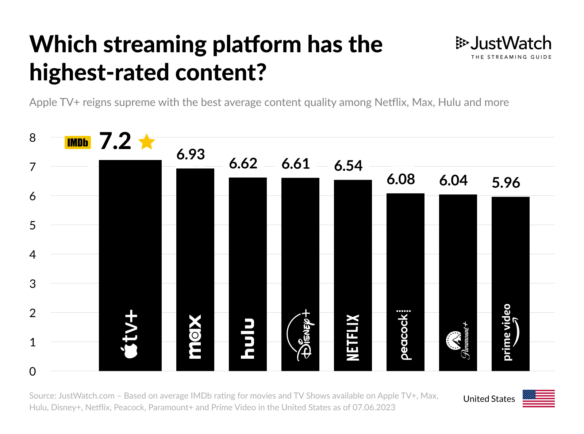(0) I’m visiting my brother to help celebrate his birthday. That’s my real excuse!
(1) EATING THE FANTASTIC. Scott Edelman invites listeners to settle in for a steak dinner with Marvel’s Tom Brevoort in Episode 243 of the Eating the Fantastic podcast.
First up — dinner with Tom Brevoort, who holds the record for being the longest-running editor ever at Marvel Comics, having been hired there in 1989 right out of college. Over the decades, he’s overseen titles such as New Avengers, Civil War, and Fantastic Four. He became Executive Editor in 2007, and in January 2011, was promoted to also serve as Senior Vice President of Publishing. He’s an Eisner Award-winner for Best Editor, and is currently the Group Editor of The X-Men.

We discussed how a guy whose first love was DC Comics ended up at Marvel, why he hated his early exposure to Marvel so much he’d tell his parents not to buy them because “they’re bad,” the pluses and minuses of comic book subscriptions (and the horror when issues arrived folded), how Cerebus the Aardvark inspired him to believe he could build a career in indie comics, the most unbelievable thing he ever read in a Flash comic, how he might never have worked at Marvel had I not gone to school with Bob Budiansky, the prevailing Marvel ethos he disagreed with from the moment he was hired, what it takes to last 35 years at the same company without either walking off in disgust or getting fired, the differing ways Marvel and DC reused their Golden Age characters, how to prevent yourself from being pedantic when you own an encyclopedic knowledge of the history of comics, and much more.
(2) ANYONE READING THIS A MILLENNEA IN THE FUTURE. [Item by SF Concatenation’s Jonathan Cowie.] Nature’s two-week Christmas edition is out, and some wag (possibly known to Filers) has a time-travel, prediction letter published…. “If anyone’s reading this Correspondence in 1,130 years’ time, please let us know”. Alas, it is behind a paywall, but due to a little Filer magic…
If anyone’s reading this Correspondence in 1,130 years’ time, please let us know
By Jonathan Cowie
In 1993, as part of Nature’s series of ‘Hypotheses’ articles, astronomer J. Richard Gott III proposed that, assuming the Copernican principle — no observer of the Universe is special — a random observer is likely to encounter an object during the mid-95% window of the object’s lifetime. The length of time for which something has been observable in the past is thus a rough measure of how long it is likely to be observable for in the future (R. J. Gott III Nature 363, 315–319; 1993).Nearly a year later, a correspondent wrote in applying Gott’s analysis to Gott’s own paper, estimating that the appearance of the Correspondence implied there was a 95% probability that the paper would still be being read in 30.6 years’ time (G. Hewlett Nature 368, 697; 1994). I replied that if I had a Correspondence published in 30 years’ time, in 2024, then following Gott’s calculations, this would considerably extend the period of appreciation of Gott’s work (J. Cowie Nature 369, 194; 1994) — by more than a millennium, I now calculate.
This is that Correspondence. Alas, I shall not be around in 1,230 years’ time to write again.
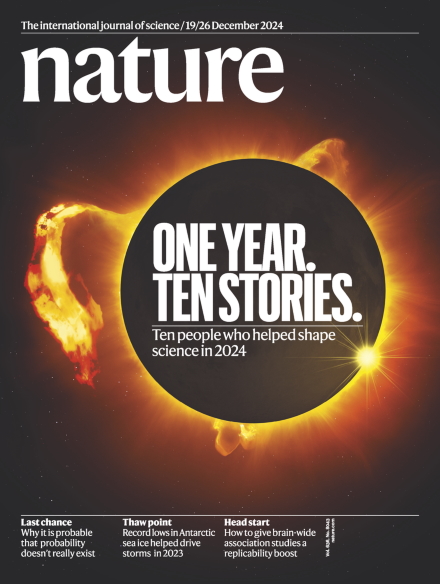
(3) LOJO’S CHOCOFFEE DRINK. [Item by Cat Eldridge.] Lojo Russo who was a member of Cats Laughing along with what seemed like most of the Minneapolis SFF writing community in the Eighties shares Lojo’s ChoCoffee drink which surely is suitable as a holiday drink.
Coffee: Jamaica Blue Mountain – rich & nutty, or dark roast Italian — if you like your coffee with an edge.
Chocolate: 1 part heavy cream, 1/2 ;part dark chocolate syrup, 1/4 part sweetened condensed milk (depending on your sweet tooth), vanilla or almond flavoring (vanilla for Jamaica, almond for Italian) — Blend.
Pour chocolate mixture slowly, gently, lovingly into coffee until it suits your tongue. If you’re like my Italian grandfather, who taught me how to enjoy coffee when I was 8, there will be more chocolate cream than coffee.
(4) MEMORY LANE.
[Written by Cat Eldridge.]
Letters from Father Christmas by J.R.R. Tolkien
Every Christmas between the years 1920 and 1943, the ever-so-blessed children of J.R.R. Tolkien received some of the most unique mail that a child could ever hope for: letters from Father Christmas himself! Beautifully illustrated and delivered in various ways, they told of all kinds of things that happened at the North Pole, and about the folk who lived there with Santa. There is the accident-prone and sleepy North Polar Bear and his two cousins who cause havoc, the evil goblins, and of course the elves and gnomes, not to mention snowfolk and cave bears. The letters came, or so it is claimed by those who don’t believe in Father Christmas, from the Tolkien children’s father, J.R.R. Tolkien himself.
In the published collection of these charming letters, we can read how the North Pole came to be snapped in half, why Santa had to move house, what a polar bear’s writing looks like (blocky is the best description) and how Santa had to defend his home from goblins. While this book does not directly connect to Tolkien’s Middle Earth mythos, it is easy for anyone versed in that mythos to recognize the origin of some of its characters in these letters. The goblin attack on Santa’s cellar will become the Goblin-Elf wars in The Lord of the Rings, and Santa’s elf-secretary Ilbereth is the obvious progenitor of the ancient elf-queen Elbereth. We even get a fully developed look at elvish writing and the goblin alphabet!
I’ll return to the book that is Letters From Father Christmas, but let me turn now to a reading of the Letters that I recently attended. In my opinion, the Letters truly don’t come to life for modern-day readers unless they are treated to an oral performance of them by accomplished actors. Surely the Tolkien children had the Letters read aloud to them when they received them as ‘mail’ from Father Christmas. The reading I attended took place in the front area of Longfellow Books, a wonderful independent store in downtown Portland, Maine. Kirsten Cappy, publicity manager for Longfellow, gave this introduction before the reading:
On September 3rd, 1973, my father sat at the breakfast table with a bowed head and proclaimed, “Children (he never called us that), today, a god passed from this world.” Now this was a confusing statement from an ardent atheist who declared even our brief foray into the Unitarian church to have been ‘too constricting’. ‘God’ was placed in the same category as ‘Santa Claus’ in our family. Both were classified as something ‘other children believed in and that we could believe in if we felt so inclined.
The ‘god’ my father spoke of was J.R.R. Tolkien, who had passed away the previous day. My brother and I managed to breathe out the question of ‘who?’ before we were waved away and my father dug mournfully into his cornflakes. Our question was answered that night at bedtime when my father opened his battered copy of The Hobbit and began to read.
The three of us read through The Hobbit and each volume of The Lord of the Rings over a year’s worth of bedtimes. Tolkien’s stories are still synonymous with the bedroom I had at that age and the gaping closet that surely housed Orcs.
I have gone on to like fiction of all sorts, but nothing has matched the intensity and obsession that Tolkien brought to his creation of Middle Earth. His professional, scholarly fascination with the dead and evolved languages of England led him to read Norse myth. He then began to create myths of his own and to create languages to feed the mouths of his myth-makers.
Lying in my bed at night I often pictured Tolkien writing, but I never pictured my father’s god with children. He had, in fact, three children and took the time from his research and his conquest of Middle Earth to play the role of Father Christmas each year. Each year for 23 years there would be a letter on the mantle piece from Father Christmas addressed to the Tolkien children. The letters spoke of each year’s chaotic preparation for Christmas, about Father Christmas’ helpers and about the mishaps that would cause some of the promised gifts to never arrive. The Tolkien children would also address letters to the North Pole. The letters were full of Christmas wishes and curious questions about life at the North Pole and about Father Christmas’ companions, Polar Bear and Ilbereth The Elf. Answers would come from Father Christmas and his helpers with lavish descriptions and detailed drawings.
With us tonight are our favorite Portland actors, Moira Driscoll, Mark Honan and Daniel Noel who comprise The Usual Suspects. The Usual Suspects give dramatic readings of modern and classic fiction bi-monthly at Longfellow Books, where they are the resident performance group. (You will note the extravagant whiskers on Daniel and Mark — they are both appearing in The Christmas Carol at Portland Stage Co.) Tonight they will be reading aloud Tolkien’s Letters from Father Christmas in the voices of Father Christmas, Polar Bear and Ilbereth The Elf. I will pass around copies of the book, so you can look at Tolkien’s sweet, obsessive drawings of the North Pole.
By the end of this introduction, the crowd of some forty folks, half adults and half children, including the offspring of several of the performers, had settled in their seats with cookies and hot drinks in hand. Now it was time for the reading…
Two of the actors, Mark Honan and Daniel Noel, were members of the cast of the recent run of A Christmas Carol at the Portland Stage Company, which was staged at Portland Performing Arts Center. Mark Honan, (Cratchit in A Christmas Carol), who played Father Christmas, is a native of England; Daniel Noel (Marley’s Ghost and several other roles, including the Narrator) was the North Polar Bear — fitting given his charming bear-like nature; and Moira Driscoll played the supercilious elf Ilbereth. They sat side by side with their copies of Letters From Father Christmas in hand — I have the copy Daniel read from complete with his post-it notes! — looking absolutely tinkly. And each read the letters as if they were Father Christmas, the North Polar Bear, or Ilbereth. I truly believed that these were letters from Father Christmas to the Tolkien children (keep in mind that this Father Christmas is not by any means a Christian-based being, but rather a sort of friendly teller of tales about what happens during the course of the year at the North Pole).
And oh, what adventures they told on that cold night! They did not read all the Letters — for that pleasure, you’ll need to listen to Derek Jacobi and his friends do it. But they read for about forty-five minutes, the right amount of time on a cold winter’s night, and their selections gave the enthralled listeners a delightful time indeed. Tolkien’s language in these letters is clearer and more playful than in The Lord of The Rings. Just read these lines, which Daniel performed with a gruff voice and a glimmer in his eye: ‘Polar Bear was allowed to decorate a big tree in the garden, all by himself and a ladder. Suddenly are heard terrible growly squealy noises. We rushed out to find Polar Bear hanging on the tree himself! ‘You are not a decoration,’ said Father Christmas. ‘Anyway, I am alight,’ he shouted. He was. We threw a bucket of water on him. Which spoilt a lot of the decorations, but saved his fur.’
If Tolkien intended The Lord of The Rings to be a ‘mythology for England,’ it’s clear to me that these Letters were a personal mythology for him and his children. No matter that there are reflections of his darker work here — this reading shows beyond any doubt that the Letters were a refuge from the stark realities of being a relatively poorly compensated academic. Even if the children didn’t always get Christmas presents, they did get a letter from Father Christmas.
I turn my attention back to the new edition of Letters From Father Christmas, which was the basis of this performance. This is the first time that all of the letters have been published. What you get are facsimiles of the letters in all their glorious messiness along with a printed version on the facing page in what appears to be a Palatino font so that you can actually read them. This is important, as the handwriting of Father Christmas (roundish like ink dripping from a fountain pen on its last legs), North Polar Bear (chunky — he has big paws), and Ilbereth (best described as spidery) is less than readable.
And the Letters are most definitely worth reading, as they do form an ongoing story that Tolkien very obviously relished telling in the same manner that he first told The Hobbit to his children: as an unfolding narrative over a period of time. It’s worth your time to see how much effort he put into the Letters — handwritings, drawings, quirky borders — all are here. What his children made of them is not known, nor I suppose does it matter now that they belong to all who read them, but I would have preferred Baillie Tolkien, daughter-in-law of J.R.R., to have given us just a bit more context. I even checked The Letters of J.R.R Tolkien to see if there was anything there about these letters, but not according to the index.
My recommendation is that you read these aloud to anyone who will listen, as hearing them does enhance their charm. Barring that, turn the lights down low, sink deep into that overstuffed chair by the fireplace, drink your cocoa, and listen to the cold winter’s wind howl outside as you read. Listen… Is that the North Polar Bear making his way across the roof? Or is it the Goblins attacking again?

(5) TUNE IN. At Spotify you can access “The Gift – a playlist by The Ray Bradbury Center”.

(6) RIPLEY’S BELIEVE IT. [Item by Steven French.] The Guardian’s review of the West End production of Shakespeare’s The Tempest ends with ‘come for Sigourney Weaver, stay for the weird magic’: “The Tempest review – Sigourney weaves weird magic in West End debut”.
SIGOURNEY Weaver, the latest in the line of high status screen stars to be wooed to the stage by director Jamie Lloyd, may for ever be known as Ellen Ripley to fans of her defining science fiction role on film. She is certainly in alien territory here, and plays Prospero with the steely-voiced conviction of a commander giving urgent instruction to an interstellar space crew at imminent risk of attack. She is making her West End debut in this late Shakespearean drama as its gender-reversed central sorcerer and usurped Duchess of Milan, and the remote isle of sounds and sweet airs which she sequesters appears to be floating in deep space…
(7) THE ORIGINAL RIPLEY. Meanwhile, BBC Sounds is offering the episode of Witness History that explains the origins of “Robert Ripley and the ‘Believe It or Not’ empire”.
In December 1918, sports writer and cartoonist Robert Ripley was struggling to find some content for his column in the New York Globe. So he compiled and illustrated some of the quirkiest sports facts from the year and created what would go onto become the ‘Believe It or Not’ cartoon.
Its popularity grew and, by the time of America’s Great Depression, Ripley was a multi-millionaire who would travel the world on his hunt for more weird and wonderful facts.
His empire expanded into radio and, in 1940, he persuaded the Duke of Windsor – who had abdicated from the throne in 1936 – to give his first commercial radio appearance.
John Corcoran, exhibits director at Ripley’s, tells Vicky Farncombe about that historic moment.
This programme also includes archive courtesy of the Ripley’s Believe It or Not! Archives.
(8) MASTODONTIA. “They Thought It Was an Old Baseball. It Was a Mastodon Tooth.” – the New York Times tells the story (behind a paywall).
…The box was opened. What he saw inside — two yellowed teeth from a long-dead mastodon — stirred in Dr. Harris a thrill he hadn’t felt in years.
“I was crazy excited,” said Dr. Harris, 50, who has worked in archaeology for nearly 30 years. “It was the same old-school excitement I felt when I got into this field in the first place.”
The discovery of the remarkably well preserved mastodon jaw was announced Tuesday by the New York State Department of Education, which runs the New York State Museum, where scientists are studying the artifact. Fearful that their home near Scotchtown, N.Y., would be overrun by news crews or treasure hunters, the couple declined to be named or interviewed for this article.
According to Dr. Harris, the mastodon jaw was discovered when the couple noticed something poking out of the grass in their backyard.
At first they thought it was an old baseball. It was not a baseball. A little digging revealed two enormous teeth buried in the soil, just inches below the surface. Realizing that this might be something of scientific importance, the homeowners reached out to Dr. Harris. The authenticity of the teeth was apparent immediately, he said, so he contacted Robert Feranec, director of research and collections at the state museum. In October the two scientists organized a small team to excavate a trench 14 inches deep.
There they found the jaw of an adult mastodon — a cousin to the woolly mammoth, which roamed North America until it went extinct about 10,000 years ago. There were also fragments of a toe and a rib. If the homeowners agree, Dr. Harris and Dr. Feranec hope to return to the yard next summer, after the ground has thawed, to see if more of the mastodon is hidden there….
…While it may be uncommon for homeowners to uncover ice age fossils poking out of their yard, the discovery of mastodon bones in Orange County is not exactly rare. In 1780, a preacher named Robert Annan found a collection of enormous bones on his farm in Wallkill, N.Y. The discovery was deemed so important that Gen. George Washington, then the commander of the Continental Army, left his troops camped at Newburgh, N.Y., and rode 25 miles in a sleigh to see the bones himself.
Washington’s viewing party gathered just a few miles from the backyard where the latest fossils were found.
“The highest concentration of mastodons in the country is in Orange County,” said Dr. Feranec, who counted about 60 findings in the area since colonial times.
Orange County is a popular resting place for mastodons because it not only offered ideal places for the animals to live, but also the right conditions to preserve them after they died….
(9) JOLLY OLE ENGLAND. “Scientists think they know why Stonehenge was rebuilt thousands of years ago” says Yahoo!
Scientists made a major discovery this year linked to Stonehenge — one of humanity’s biggest mysteries — and the revelations keep coming.
A team of researchers shared evidence in August suggesting that the Altar Stone, an iconic monolith at the heart of Stonehenge, was transported hundreds of miles to the site in southern England nearly 5,000 years ago from what’s now northeastern Scotland. Just a month later, a report led by the same experts ruled out the possibility that the stone came from Orkney, an archipelago off Scotland’s northeastern coast that’s home to Neolithic sites from that time frame, and the search for the monolith’s point of origin continues.
Now, research building on the two previous studies suggests that Stonehenge may have been reconstructed in England around 2620 to 2480 BC to help unify ancient Britons as newcomers arrived from Europe. The new study, published Thursday in the journal Archaeology International, also reveals how Neolithic people may have moved the 13,227-pound (6-metric-ton) block over 435 miles (700 kilometers) from where it originated….
…Construction on Stonehenge began as early as 3000 BC and occurred over several phases in an area first inhabited as early as 5,000 to 6,000 years ago, according to the researchers.
Previous analysis has shown that bluestones, a type of fine-grained sandstone, and larger silicified sandstone blocks called sarsens were used in the monument’s construction. The bluestones were brought from 140 miles (225 kilometers) away at the Preseli Hills area in west Wales and are thought to have been the first stones placed at the site. The sarsens, used later, came from the West Woods near Marlborough, located about 15 miles (25 kilometers) away.
Researchers believe the Altar Stone was placed within the central horseshoe during a rebuilding phase. While the exact date is unknown, the study authors believe the stone arrived between 2500 and 2020 BC.
It’s during that rebuilding phase, according to the research, that Stonehenge’s builders erected the large sarsen stones to form an outer circle and an inner horseshoe made of trilithons, or paired upright stones connected by horizontal stone beams, which remain part of the monument to this day.
The Altar Stone is the largest of the bluestones used to build Stonehenge. Today, the Altar Stone lies recumbent at the foot of the largest trilithon and is barely visible peeking through the grass….
(10) WHAT ISN’T? CBR.com argues that “Lord of the Rings Film Is Secretly a Christmas Movie”. It’s clickbait, but since I clicked…
…Unlike in The Chronicles of Narnia, Christmas was not celebrated in The Lord of the Rings, but December 25 was still a significant date in Middle-earth’s history. When Frodo first awoke in Rivendell in The Fellowship of the Ring, Gandalf told him that it was “ten o’clock in the morning on October the twenty-fourth,” which matched the timeline from J. R. R. Tolkien’s The Lord of the Rings novel. Based on the order of scenes from the extended edition of the film, it seemed that the Council of Elrond was held the next day and that the Fellowship departed from Rivendell the day after that. But as revealed in the novel, an entire month passed between the Council of Elrond and the Fellowship’s departure, giving Frodo additional time to recover from his Morgul wound. When he and his companions finally set out on their journey to destroy the One Ring, it was December 25, which would have been Christmas Day in the real world. If Die Hard can count as a Christmas movie because it takes place on Christmas Eve, The Fellowship of the Ring should qualify as well…
(11) VIDEO OF THE DAY. “Star Wars Prequels Bloopers” from seven years ago. So it’s just getting ripe…
[Thanks to Cat Eldridge, SF Concatenation’s Jonathan Cowie, Steven French, Scott Edelman, Mark Roth-Whitworth, Kathy Sullivan, Teddy Harvia, Mike Kennedy, Andrew Porter, John King Tarpinian, and Chris Barkley for some of these stories. Title credit belongs to File 770 contributing editor of the day OGH.]




